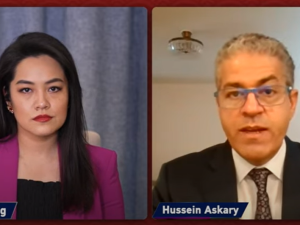Afskrift af Hr. Abbas Rasoulis tale til
Schiller Instituttets of EIR’s seminar på Frederiksberg den 18. april 2016

Kommer senere på dansk.
Abbas Rasouli, the First Secretary at the Embassy of the Islamic
Republic of Iran in Denmark: Address to {EIR}-Schiller Institute
Seminar “Extend the New Silk Road to the Middle East and Africa”
April 18, 2016
THE SILK ROAD AND THE IRAN FACTOR
ABBAS RASOULI: In 2013 China proposed to build an “economic belt
along the Silk Road,” a trans-Eurasian project spanning from the
Pacific Ocean to the Central Asian countries all the way to
Europe.
The New Silk Road already have momentum. In early 2015 China
announced $62 billion of its foreign exchange reserves will be
made available to the three state-owned policy banks that will
finance the expansion of the new Silk Road.
Beyond Central Asia the economic belt along the Silk Road
can also provide the vehicle for China’s expansion of its trade
relations with both the Middle East and Europe. And here is when
the Iran link comes into the equation.
In February 2016 a freight train from Yiwu in China’s
eastern Zhejiang province arrived in Tehran. The China-Iran “Silk
Road train” is a part of the overland component of China’s One
Belt, One Road (OBOR) initiative.
The train used the existing rail links from China through
Kazakhstan and Turkmenistan before entering Iran. It took the
train just 14 days to cover the roughly 10,399 km long journey to
Tehran whereas ferrying cargo via the sea from Shanghai, which
lies 300 km north of Yiwu, to the Iranian port of Bandar Abbas
takes 45 days in comparison.
It is expected that construction of new high-speed rail
links through Central Asia will enable trains carrying goods to
run further on to European markets. Besides facilitating
Sino-Iran trade, these railway lines will contribute to Iran’s
emergence as an important Eurasian trade hub. Iran will thus be
integrated more into the economies of East and Central Asia as
well as Europe.
Bilateral trade between Iran and China grew from $4 billion
in 2003 to $53 billion in 2013. In January 2016, during the visit
of Chinese President Xi Jinping to Iran, the two sides agreed to
increase trade to $600 billion over the coming decade. So the
operation of this railway link will prove an important factor in
the development of trade between Iran and the countries along
this economic belt.
The important thing about the Iran corridor is that existing
road and rail links between China, Central Asia and Iran only
needs to be modernized whereas some parts or all of the other
corridors have to be constructed from scratch, each with their
own security and geographical challenges.
The Yiwu-Tehran railway is just one of the many projects
that enhance regional connectivity, bringing together China,
Central Asia, the Persian Gulf and West Asia.
India, has also been eyeing overland access via Iran to
Central Asian and European markets too. In this connection the
North-South Transport Corridor (NSTC), a multi-modal trade
transport network that includes sea and rail transport from India
via Iranian ports on the Persian Gulf to as far as the Baltic Sea
via Russia, was initiated by Russia, India and Iran in September
2000 to establish transportation networks among the member states
and to enhance connectivity with the land-locked region of
Central Asia. Among the few routes in this corridor the
Mumbai-Chahbahar or Bandar Abbas (Persian Gulf)-Anzali-Astara
(Iran Caspian Sea)-Astara (Azerbaijan)-Baku-Russia-
receiving much attention. With the completion of this route Iran
will emerge as another important transit hub in the Asia-Europe
trade giving India overland access to Europe as well.
Of the 1500 km Bandar Abbas-Bandar-Anzali railway link only
50 km remains to be completed, but the 164 km Anzali-Astara link
is still at negotiation stage. A working group made up of India,
Iran, Azerbaijan and Russia has been formed to look into raising
finance to construct the Anzali-Astara (Iran)-Astara (Azerbaijan)
railway connection. All parties appreciate the urgency of moving
this project forward and as recently as last week, Russia,
Azerbaijan and Iran agreed to speed up the project.
The North-South corridor, when completed, is expected to
significantly reduce the time of cargo transport from India to
Central Asia and Russia. At present, it takes about 40 days to
ship goods from Mumbai in India to Moscow. The new route will be
able to cut this time to 14 days.
The primary objective of the NSTC project is to reduce costs
in terms of time and money over the traditional route currently
being used between Russia, Central Asia, Iran and India. With
improved transport connectivity their respective bilateral trade
volumes are most likely to increase tremendously. According to
various studies the route, once fully operational, will be at
least 30% cheaper and 40% shorter than the current traditional
route.
Though every country is important in any transport chain,
Iran, neighbor with 15 countries, is not only a hub for
distribution to the neighboring countries of about 400 million
but has the added advantage of being a strong economy between
giants at each end of these corridors namely China, India, Russia
and Europe.
Some of the economic advantages of Iran are:
* The 18th largest economy in the world by purchasing power
parity (ppp);
* A diversified economy with a broad industrial base;
* Resource-rich economy;
* Labor-rich economy;
* Young and educated population;
* Large domestic market;
* An increasingly sophisticated infrastructure and human
capital base providing the foundation for an emerging
knowledge-based economy.
* A market of 80 million with easy access to another market
of 400 million.
In a global world where international trade is taking on
greater significance, transport costs and delivery time are two
of the most important factors in the choice of the mode and route
of transporting goods.
The completion and modernization of the North-South and
East-West Transport corridors will cut transport costs and
delivery time thereby enhancing trade between East Asia, South
Asia, Central Asia, Middle East and Europe.







